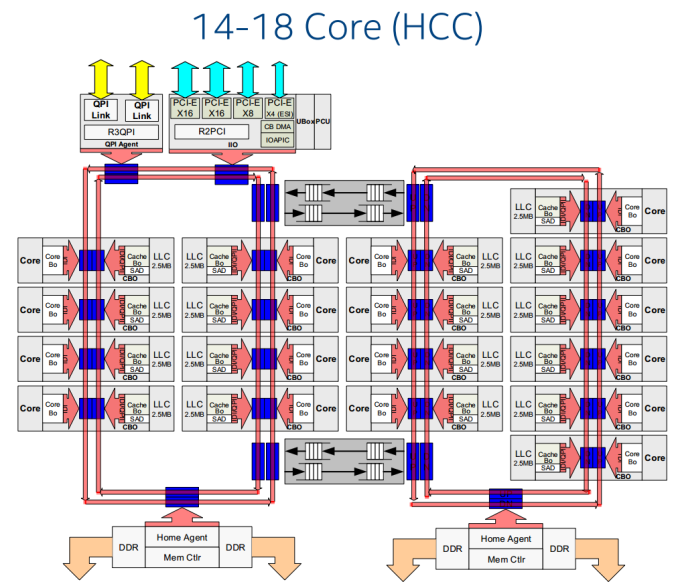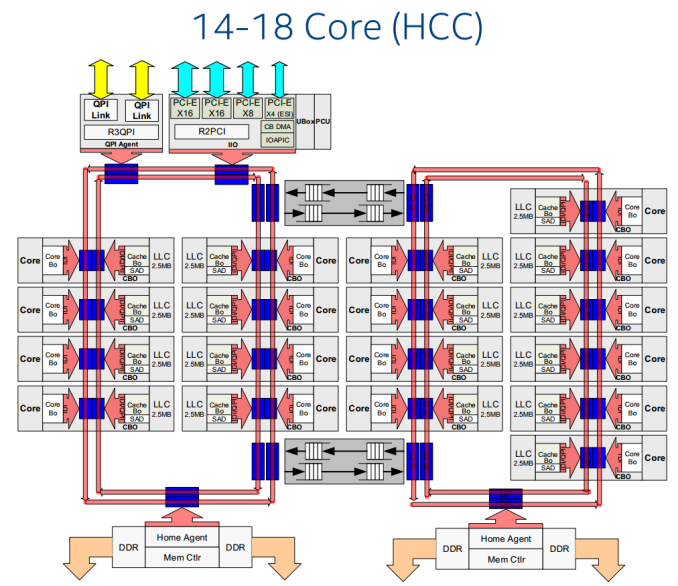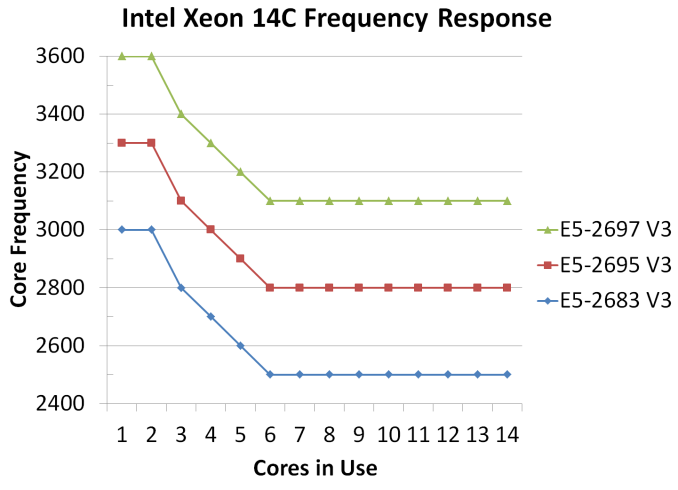Intel Haswell-EP Xeon 14 Core Review: E5-2695 V3 and E5-2697 V3
by Ian Cutress on November 20, 2014 10:00 AM EST
Moving up the Xeon product stack, the larger and more complicated the die, the lower the yield. Intel sells its 14-18 core Xeons from a top end design that weighs in at over five billion transistors, and we have had two of the 14C models in for review: the E5-2695 V3 (2.3 GHz, 3.3 GHz turbo) and E5-2697 V3 (2.6 GHz, 3.6 GHz turbo).
The Information
It can only take one particular transistor to fail to break a whole CPU. If it happens in a core as part of the logic or caches, that core can be fused off and the die can sold as a lower core part. This is how yields are improved, by reusing the dies that have errors in removable sections. Ultimately this reduces the maximum amount of profit on offer, but it enables CPU manufacturers like Intel and AMD to sell a range of products, rather than just one from a single design. The way Intel designs its high end E5 V3 Xeons, from an 18-core die, means that its 14 core components either have at least two defects, or are perfectly fine 18 core models but need to fill up demand.
| CPU Specification Comparison | |||||||||
| CPU | Node | Cores | GPU | Transistor Count (Schematic) |
Die Size | ||||
| Server CPUs | |||||||||
| Intel | Haswell-EP 14-18C | 22nm | 14-18 | N/A | 5.69B | 662mm2 | |||
| Intel | Haswell-EP 10C-12C | 22nm | 6-12 | N/A | 3.84B | 492mm2 | |||
| Intel | Haswell-EP 6C-8C | 22nm | 4-8 | N/A | 2.6B | 354mm2 | |||
| Intel | Ivy Bridge-EP 12C-15C | 22nm | 10-15 | N/A | 4.31B | 541mm2 | |||
| Intel | Ivy Bridge-EP 10C | 22nm | 6-10 | N/A | 2.89B | 341mm2 | |||
| Consumer CPUs | |||||||||
| Intel | Haswell-E 8C | 22nm | 8 | N/A | 2.6B | 356mm2 | |||
| Intel | Haswell GT2 4C | 22nm | 4 | GT2 | 1.4B | 177mm2 | |||
| Intel | Haswell ULT GT3 2C | 22nm | 2 | GT3 | 1.3B | 181mm2 | |||
| Intel | Ivy Bridge-E 6C | 22nm | 6 | N/A | 1.86B | 257mm2 | |||
| Intel | Ivy Bridge 4C | 22nm | 4 | GT2 | 1.2B | 160mm2 | |||
| Intel | Sandy Bridge-E 6C | 32nm | 6 | N/A | 2.27B | 435mm2 | |||
| Intel | Sandy Bridge 4C | 32nm | 4 | GT2 | 995M | 216mm2 | |||
| Intel | Lynnfield 4C | 45nm | 4 | N/A | 774M | 296mm2 | |||
| AMD | Trinity 4C | 32nm | 4 | 7660D | 1.303B | 246mm2 | |||
| AMD | Vishera 8C | 32nm | 8 | N/A | 1.2B | 315mm2 | |||
I mentioned in the 12 core review that Intel can play fast and loose with their binning process, giving customers almost what they desire in terms of performance and power, as long as they are willing to pay that price. The same could be said for the 14-18 core market, but rather than offer a swathe of units, Intel offers around half a dozen ranging from a 2.0 GHz 14-core to the E5-2699 V3 2.3 GHz 18-core. Intel could release a 65W, 18 core monster, and even though it might come through at 1.2 GHz, this type of SKU is not on the roadmap (unless, perhaps, you meet the high minimum order quantity). If given the opportunity, I would like to see the process by which Intel decides to select which SKUs to bin for retail vs. OEM and custom parts. I suspect it is a combination of part market demand, part yield, part wishful thinking, but I would hope it is at least systematic. Based on the core orientation image below, there might be complications dealing with that final column of six cores, against the other columns of four, either in voltage response characteristics or discrete production errors which might also have another effect.
Our samples in today come in with the E5-2695 V3 at 2.3 GHz base frequency (3.3 GHz turbo) and the E5-2697 V3 at 2.6 GHz (3.6 GHz turbo). When considering the Xeon naming stack, each number from 2695 to 2699 is taken except from 2696, and as such one might humorously postulate that Intel is merely running out of SKU names. Though an added L or W might find its way in if more models joined the list.
In our last test, as well as previous reviews, the results showed that a 2P system, such as the dual E5-2650L V3s, performed poorly in most of our testing software compared to having one big single CPU in a 1P socket in most circumstances. The 1P arrangement tends to outperform a 2P system when the software is not built to take advantage of the NUMA arrangement. Intel does sell CPUs like the E5-1691 V3, a 14 core chip for 1P systems, or we can go straight into the E5-2699 V3 for 18 cores, but there will always be a market for 2P players who need the large memory capacity or who use software similar to Cinema 4D that is NUMA aware.
| Intel Xeon E5 2600 v3 SKU Comparison | ||||
| Xeon E5 | Cores/ Threads |
TDP | Clock Speed (GHz) Base - Turbo |
Price |
| High Performance (35-45MB LLC) | ||||
| 2699 v3 | 18/36 | 145W | 2.3-3.6 | $4115 |
| 2698 v3 | 16/32 | 135W | 2.3-3.6 | $3226 |
| 2697 v3 | 14/28 | 145W | 2.6-3.6 | $2702 |
| 2695 v3 | 14/28 | 120W | 2.3-3.3 | $2424 |
| "Advanced" (20-30MB LLC) | ||||
| 2690 v3 | 12/24 | 135W | 2.6-3.5 | $2090 |
| 2685 v3 | 12/24 | 120W | 2.6-3.5 | $2090 |
| 2680 v3 | 12/24 | 120W | 2.5-3.3 | $1745 |
| 2660 v3 | 10/20 | 105W | 2.6-3.3 | $1445 |
| 2658 v3 (E) | 12/24 | 105W | 2.2-2.9 | $1832 |
| 2650 v3 | 10/20 | 105W | 2.3-3.0 | $1167 |
| Midrange (15-25MB LLC) | ||||
| 2640 v3 | 8/16 | 90W | 2.6-3.4 | $939 |
| 2630 v3 | 8/16 | 85W | 2.4-3.2 | $667 |
| 2620 v3 | 6/12 | 85W | 2.4-3.2 | $422 |
| Frequency optimized (10-20MB LLC) | ||||
| 2687W v3 | 10/20 | 160W | 3.1-3.5 | $2141 |
| 2667 v3 | 8/16 | 135W | 3.2-3.6 | $2057 |
| 2643 v3 | 6/12 | 135W | 3.4-3.7 | $1552 |
| 2637 v3 | 4/8 | 135W | 3.5-3.7 | $996 |
| Budget (15MB LLC) | ||||
| 2609 v3 | 6/6 | 85W | 1.9 | $306 |
| 2603 v3 | 6/6 | 85W | 1.6 | $213 |
| Power Optimized (20-30MB LLC) | ||||
| 2650L v3 | 12/24 | 65W | 1.8-2.5 | $1329 |
| 2648L v3 (E) | 12/24 | 75W | 1.8-2.5 | $1544 |
| 2630L v3 | 8/16 | 55W | 1.8-2.9 | $612 |
The big cores get a big power budget and a big price to match. The movement from the 2695 to the 2697 is only a few hundred MHz, but Intel charges and additional $278 for the privilege with a rise in 25 TDP. In terms of frequency response both of the CPUs follow the same path, marking an extra 300 MHz for the difference in power and price.
If we did some basic 24/365 100% use calculations, using the TDP and $0.10/kWh, The 2697 V3 would consume 1270 kWh and cost $127/yr compared to the 2695 V3 which would consume 1050 kWh and cost $105/yr. This is obviously not including any additional cooling needed, but the $22 difference in power per year against $278 in the CPU price difference would indicate 15 years of running to make up the difference. Clearly the cost per CPU matters more regarding how much work is going to be done per unit time. If the contract takes less time to complete, then it can sway the preference in terms of the faster CPU if the contract is CPU compute or response bound.
As this the third in our recent series of Xeon E5-2600 v3 performance coverage, we have covered most of the technical data in our previous two installments regarding 10 core and 12 core performance. We carry over the data from those tests, but refer back for details regarding chipset and DRAM information, as well as Johan’s extensive review covering in depth more of the server-focused aspects of the Xeon E5 v3 design.
Test Setup
As with the previous reviews, due to the timing available to test each of our CPU samples we were only able to get a limited range of E5-2695 V3 benchmark results. However, we were able to source two E5-2697 V3 CPUs for dual 14-core analysis leading to a 56-thread behemoth.
| Test Setup | |
| Processor | Intel Xeon E5-2695 V3 (120W), 14C/28T, 2.3 GHz (3.3 GHz Turbo) Intel Xeon E5-2697 V3 (145W), 14C/28T, 2.6 GHz (3.6 GHz Turbo) |
| Motherboards | ASUS X99-Deluxe ASRock X99 Extreme6 GIGABYTE MD60-SC0 |
| Cooling | Cooler Master Nepton 140XL Dynatron R14 |
| Power Supply | OCZ 1250W Gold ZX Series Corsair AX1200i Platinum PSU |
| Memory | ADATA XPG Z1 DDR4-2400 8x8 GB 1.2V Corsair DDR4-2133 C15 4x8 GB 1.2V G.Skill Ripjaws 4 DDR4-2133 C15 4x8 GB 1.2V |
| Memory Settings | JEDEC @ 2133 |
| Video Cards | AMD R7 240 DDR3 |
| Video Drivers | AMD Catalyst 13.11 |
| Hard Drive | OCZ Vertex 3 256GB |
| Optical Drive | LG GH22NS50 |
| Case | Open Test Bed |
| Operating System | Windows 7 64-bit SP1 |
Many thanks to...
We must thank the following companies for kindly providing hardware for our test bed:
Thank you to OCZ for providing us with PSUs and SSDs.
Thank you to G.Skill for providing us with memory.
Thank you to Corsair for providing us with an AX1200i PSU.
Thank you to MSI for providing us with the NVIDIA GTX 770 Lightning GPUs.
Thank you to Rosewill for providing us with PSUs and RK-9100 keyboards.
Thank you to ASRock for providing us with some IO testing kit.
Thank you to Cooler Master for providing us with Nepton 140XL CLCs.
Thank you to GIGABYTE Server for loaning us some CPUs and Dynatron CPU coolers.
Load Delta Power Consumption
Power consumption was tested on the system while in a single MSI GTX 770 Lightning GPU configuration with a wall meter connected to the OCZ 1250W power supply. This power supply is Gold rated, and as I am in the UK on a 230-240 V supply, leads to ~75% efficiency > 50W, and 90%+ efficiency at 250W, suitable for both idle and multi-GPU loading. This method of power reading allows us to compare the power management of the UEFI and the board to supply components with power under load, and includes typical PSU losses due to efficiency.
We take the power delta difference between idle and load as our tested value, giving an indication of the power increase from the CPU when placed under stress.













44 Comments
View All Comments
alacard - Thursday, November 20, 2014 - link
"Bioshock Infinite was Zero Punctuation’s Game of the Year for 2013"Who gives a shit?
alacard - Thursday, November 20, 2014 - link
They're going to kill that poor woman!ayprof - Thursday, November 20, 2014 - link
This affects all of us!osx86h3avy - Friday, November 21, 2014 - link
Mark it zero dude.ERJ - Thursday, November 20, 2014 - link
I want to know what happened to the server benchmarks? Where is the VMware / SAP stuff?romrunning - Friday, November 21, 2014 - link
I agree - I'm not sure why VM testing was left out. That is one of the highest usage scenarios for this type of processor.alacard - Friday, November 21, 2014 - link
Maybe Ian was too busy playing "Zero Punctuation’s Game of the Year for 2013" to bother.linuxnizer - Saturday, November 22, 2014 - link
Yep, need to see Red Hat Enterprise Linux 7 running few VMs (OpenStack or VMware) and serving thousands of JBoss application users with intensive DB operation. Better yet, running Oracle 12c DB with Oracle JEE over Oracle unbreakable Linux.Ian Cutress - Sunday, November 30, 2014 - link
That's more Johan's area. Johan has access to a lot more server based hardware/software than I.dgingeri - Thursday, November 20, 2014 - link
Maybe you could convince Intel to let you give away one of these samples to readers. :)